Here’s the thing: while it’s the most talked-about, ChatGPT is not the only AI out there. Especially for students.
From helping out with homework to assisting in writing and revising for tests or exams, there are a bunch of AI tools to help you with pretty much any academic task.
Now, I know it’s easy to be swayed by the (negative) public sentiment, and distrusting and avoiding AI. But if you test a few platforms, you’ll realize how genuinely helpful AI can be in becoming a better student and, overall, a more knowledgeable and tech-savvy person.
In this article, we’ll go through several cool tools and show you how you can best use them to your advantage.
Here’s what you’ll learn:
- How to use AI to improve your writing skills.
- How to do homework and study for tests with the help of AI tools.
- How to organize your research, categorize sources, and handle bibliography with AI.
- How to use AI to improve your time management and productivity.
- How and which AI to use for better collaboration and group projects.
- How to create personalized learning plans.
- How to use ChatGPT for writing, brainstorming, revising, and practicing a language.
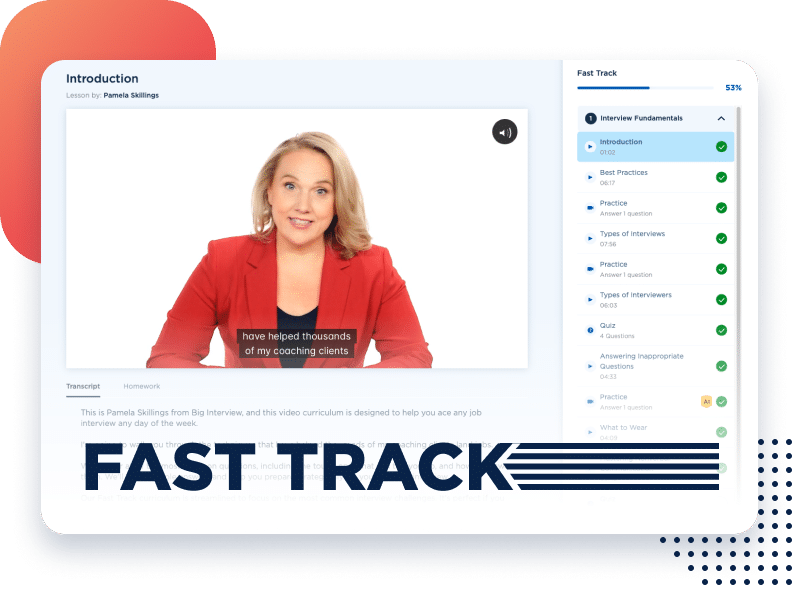
Don’t waste days compiling overused interview techniques. Get original answers to every single question you could expect.
Best AI tools for Students
- Grammarly
- QuillBot
- Hemingway App
- ProWritingAid
- Khanmigo by Khan Academy
- Socratic by Google
- Zotero
- Research Rabbit
- Scite
- Consensus
- RescueTime
- Notion
- Slack with AI bots
- Miro
- Smart Sparrow
- ChatGPT
AI-Powered Writing Tools
In summary:
- AI can assist you with different writing tasks like grammar and spelling correction and stylistic adjustments.
- Some of the most popular ones include Grammarly, Quillbot, and Hemingway App, and ProWritingAid
- Before accepting suggestions provided by AI tools, check their validity – these tools can sometimes make mistakes.
Grammarly and Quillbot are the most popular AI-powered writing tools. They help with things like grammar and spelling corrections, stylistic adjustments, vocabulary suggestions, and paraphrasing.
This way, you can focus on creative tasks like generating ideas, storytelling, providing relevant arguments, and coming up with an effective structure.
Grammarly
As its name suggests, Grammarly checks spelling and grammar. It will also provide you with suggestions on how to improve the style of your writing.

Quillbot
Quillbot can help you with writing and research. It offers features like paraphrasing, text summarizer, grammar checker, citation generator, and more.
It’s a great backup for when you hit writer’s block and need ideas on how to make your writing more impactful. It can also help you summarize big chunks of text and save you time when studying or reviewing data.
How to use it: Using Quillbot is quick and easy — you install the extension and then use it for any type of text you write. Alternatively, if you want to use it only for paraphrasing, you can do it online, on their website.
What’s awesome about the paraphrasing feature is that you can choose the style you want to use: a standard paraphrase, a formal one, academic, short, and others.
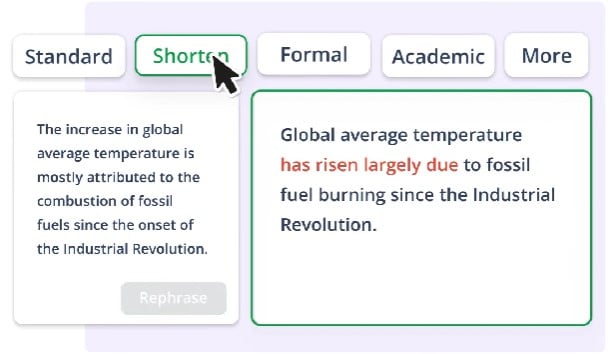
✅ AI tip: When working with Grammarly or Quillbot (or any other AI, really), check every suggestion before accepting the change.
These tools are usually good with spelling and grammar, but sometimes suggest changes that make no sense. Language is complex, so a language model won’t always understand what you want to say — AI writing tools can miss puns or humorous references, let alone deliberate errors.
They’re good at the basic stuff, not so great anymore when you want to have fun with words. Always try to find a sweet spot between being grammatically correct, and letting your personality shine through.
Take a look at this example:

Sure, Quillbot did its job and successfully paraphrased the sentence. But its version is too formal and impersonal, making it a bit boring.
Grammarly can do similar things, and even suggest straight up wrong alternatives.
For best results, bear this in mind and always check if the suggestions align with your goals, style, audience, and type of the writing task at hand.
How do you choose the best AI writing tool?
Think about your needs and goals.
For example, if you’re 100% certain in your writing abilities and enjoy displaying your creative skills, you might need help only with spelling and grammar mistakes — in this case, Grammarly is your go-to. But if you want help with rephrasing sentences and coming up with better ways to communicate your message, Quillbot will make more sense.
AI Tutoring Platforms
In summary:
- AI-powered tutoring platforms are just like tutors or study buddies – there to help you learn, revise, prepare for tests, and provide support and feedback in any way.
- They assess your strong and weak areas and create personalized, interactive learning techniques for you.
- Some of the most useful ones are Khanmigo by Khan Academy and Socratic by Google.
Imagine having your study buddy available to you 24/7. A fit of panic the night before a test? No problem, they’re there to help.
Well, that’s exactly what AI-powered tutoring platforms are.
To put it simply, they help you study pretty much any subject. Here’s how they work:
- They assess your strengths.
- They assess your weaknesses.
- They identify your learning patterns.
- They create the most effective interactive learning techniques for you.
- They provide instant feedback, so you can quickly identify your mistakes and become more efficient.
If you decide to try out some of these platforms, aim to have a structured approach. Set clear and measurable goals before each session, regularly review the feedback the platforms give you, and stay consistent with your study schedules.
Here are some tools to consider.
Khanmigo by Khan Academy
Khanmigo is an AI-powered learning platform that covers math, humanities, coding, social studies, and more.
It can help you:
- Prepare for a test.
- Revise materials.
- Write all sorts of texts.
- Learn how to debate, build strong arguments, and consider key objections.
- And even pick your career.
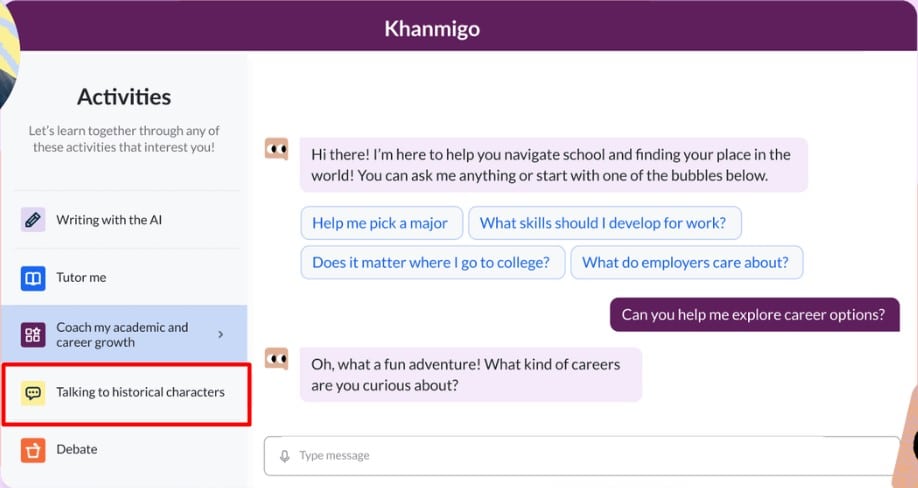
The feature that I particularly like is “Talking to historical characters.” I was always terrible at memorizing all the years, people, and details of major historical events, so I’m sure a feature like this would have saved me big time simply because of how creative and interactive it is.
How to use it: What’s interesting about Khanmigo is that it won’t give you answers, but hints to help you reach the answer yourself. This helps you memorize facts easily — your brain retains information better after a little workout like that.
And it’s available 24/7 in case you need urgent help or a last-minute practicing session before a test. Plus, there’s a text-to-speech feature, so you don’t have to type lengthy questions or prompts.
Socratic by Google
Socratic is another homework and study buddy that can help you whenever you get stuck preparing for a test, exam, or when doing homework.
It works for various subjects, like literature, math, biology, chemistry, or physics. It can help you solve equations, plan an essay, or understand difficult concepts, step-by-step.
What you can use it for:
- As a homework helper.
- As help with revising before a test.
- For research.
- For organizing study materials (summarization and notes features).
- For language practice (it can explain grammar rules).
Of course, you’ll still need to pay attention in class and do your best to follow and understand everything instead of over-relying on apps like this one — but in case you get stuck, you’ll be covered.
How to use it: Here’s an example of how you can use it for math problems. You can take a photo of an equation and scan it in Socratic:
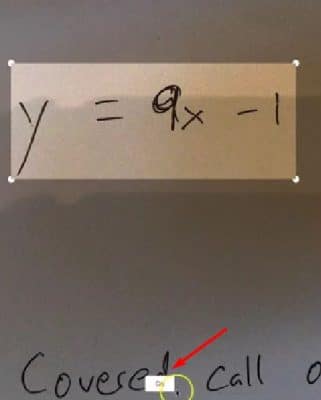
Below the image, you’ll see a button that says Go, and when you press it, Socratic will analyze the problem, provide a little explanation on it, and provide links to YouTube videos and other sources with solutions and tips:
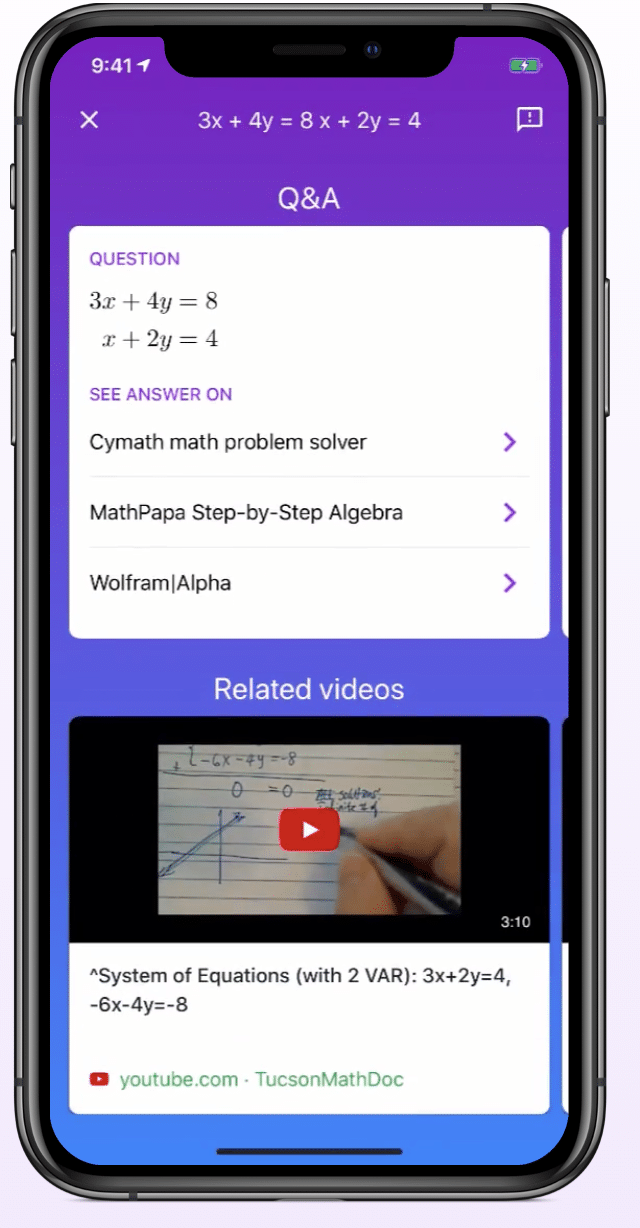
✅ Pro tip: When using Socratic for asking questions or creating prompts, bear this in mind:
- Give specific, detailed prompts.
- Ask specific questions for informative answers.
- Cross-check the information it provides.
- Use it as a supplement to your traditional study techniques — don’t over-rely on it.
AI-Driven Research Tools
In summary:
- AI-driven research tools can help you efficiently analyze data, minimize error, and simplify your research process.
- Popular and most useful ones include Zotero and Research Rabbit.
If you’re struggling with your research processes, there are some AI-driven tools to help you avoid human error, inaccurate results, and spending hours analyzing huge amounts of data.
This way you get more technical aspects of research off your plate and focus on critical thinking and unique insights.
Here are some tools you can use for research projects.
Zotero
This one is not an AI tool per se, but it’s an amazing tool we had to include on this list.
How to use it: Zotero stands out for its ability to organize research materials and manage citations easily. You’ll be able to automatically sort and categorize different documents under different tags and keywords, which is a lifesaver if you’re juggling multiple sources.
And if you need to make a quick bibliography in any citation format, you can use ZoteroBib. Zotero also instantly creates references and bibliographies for any text editor inside Google Docs, Word, and LibreOffice.
In addition to syncing your data across multiple devices, you can also co-write a paper or build a collaborative bibliography.

Research Rabbit
Research Rabbit is an AI tool for discovering related research papers and studies.
How to use it: The algorithm will analyze your research interests and provide custom recommendations for relevant research. It’s particularly useful if you’re looking to explore new angles of your topic or provide a comprehensive literature review.
As they say on their website, Research Rabbit is like Spotify for papers. Plus, it can be integrated with Zotero so you can organize all those papers once you find them.
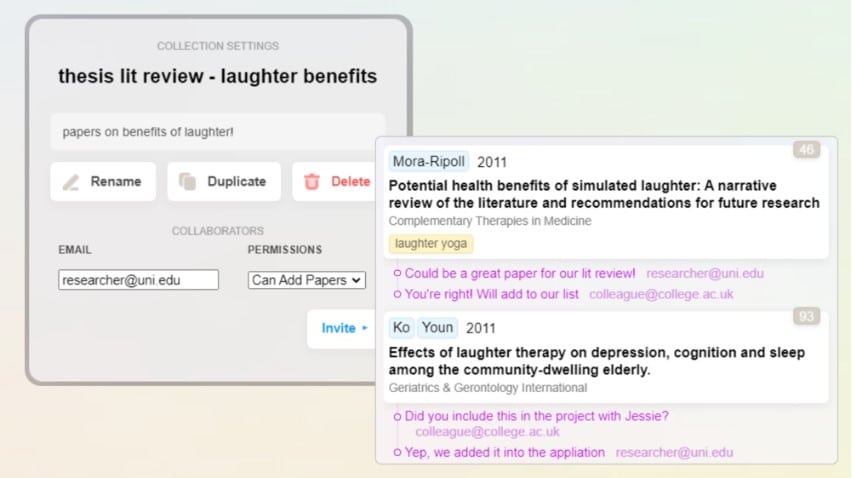
AI-Enhanced Time Management and Productivity
In summary:
- AI-powered time trackers and project management tools will help you skyrocket your productivity.
- They can give you unique insights into your time management and areas to improve it, and help with breaking down your projects into manageable chunks.
- For great results, try RescueTime and Notion.
AI-Enhanced time management and productivity tools will help you manage your tasks, sort out your schedules and notes, prioritize certain courses or subjects you’ll soon be tested on, or create templates for easier learning.
How to use these tools
For example, you can create separate tasks for different things you’re working on. If you’re preparing for an upcoming exam or a test, you can prioritize it and create subtasks with clear deadlines for each smaller task you need to complete in order to prepare.
If I had these tools available back in the day, here’s how I’d use them to prepare for the biggest exam I had, a course on Shakespeare.
I’d break the course down and create different subtasks for different elements I had to study for:
- Analyzing and summarizing key sonnets
- Analyzing and summarizing key dramas
- Revising Shakespearian words and their meaning
- Revising historical context and the Elizabethan era
- Revising theory on the Globe theater
Each subtask would have due dates so that I know which one I’m focusing on and when. Each would contain elaborate notes on what I need to work on, what I need to check with my professor, what I got right, what I can’t get right, and similar.
I could even set up a progress tracker with a percentage bar I could update regularly and keep track of where I stand.
You get the drill — with a bit of effort, you could create an elaborate plan to get more productive and set clear goals to reach key milestones.
RescueTime
RescueTime is a time tracker app that could give you insights into your working habits, where you lose the most time, and websites and documents you spend the most time on — based on which you can assess your time tracking skills and efficiency and adjust your approach.
It also offers an Assistant feature that helps you keep track of your schedules, time blocks, alerts, and generally daily plans.
How to use it: If I were to use this during my Shakespeare exam preparation, I’d set it up so that I can track how much time I spend on each of the tasks I outlined above.
If I see that I consistently revise the context and Elizabethan history within 30 minutes, that would be a green flag. But if analyzing key dramas takes me anywhere from 60 to 120 minutes, this inconsistency would raise a red flag that I’m not 100% prepared for that topic and I could focus on it until I get consistent results.
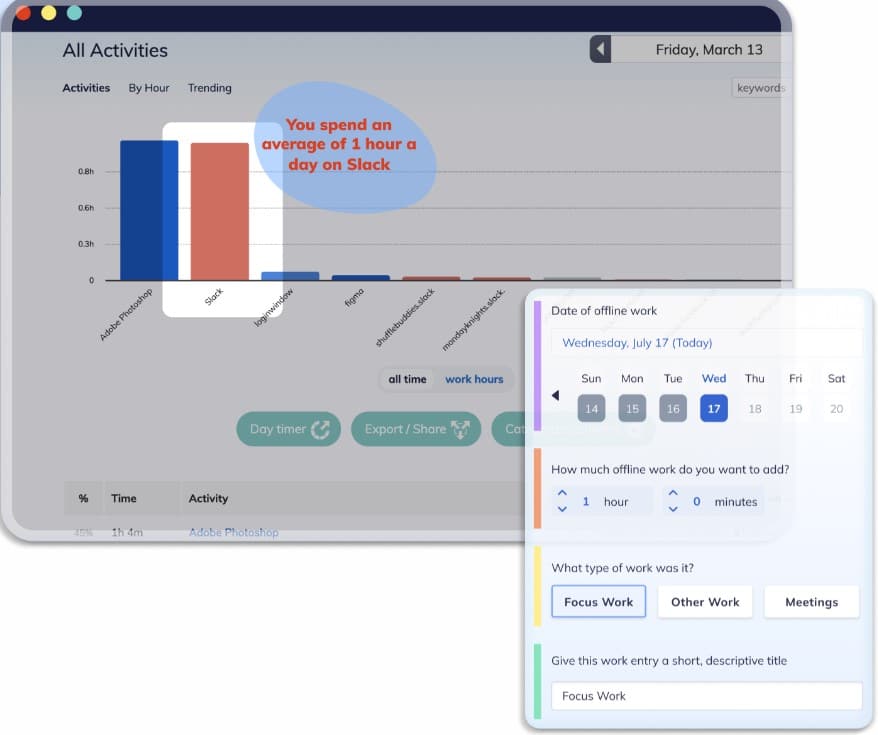
A final word: There are many time trackers and project management tools you can use, and they all work pretty much the same way. In addition to the ones we cover in this section, you could also try Asana, Toggl, Trello, and others — each one is cool, but some will suit you better than others, based on your needs.
Notion
Notion is a project management tool you can use to break down your weekly, monthly, or yearly goals, keep track of your progress, create separate tasks or cards, or even break down courses or subjects by different areas.
It’s like an empty board where you get to cut out different bits and pieces of information and group them together.
How to use it: To go back to my Shakespeare example:
- I’d create tasks for different study areas, like mentioned above (summarizing key sonnets, key dramas…)
- Set due dates for each and create a calendar for milestones
- Write down reminders, notes, key points
To go one step further, I could use Notion’s Q&A AI feature to help me organize my work. This feature works like a chatbot, and the quality and precision of its answers depends directly on the input one provides – so I’d make sure I have as many details as possible in each of my subtasks.
I’d also tell it how much time I had before the exam, and it would give me a day-by-day breakdown of what to work on in order to prepare.
Finally, I could ask it to summarize my data and create action items I can put in my calendar to have a clear overview of my timelines and milestones to hit before the exam.
✅ Pro tip: If you feel like you want to go the extra mile, you can try creating workflows for different types of tasks you do:
- Preparing for exams
- Writing essays
- Working on group projects
- Organizing extracurricular activities
This would help you be more efficient and kickstart each project easily, as you won’t feel like you’re starting from scratch.
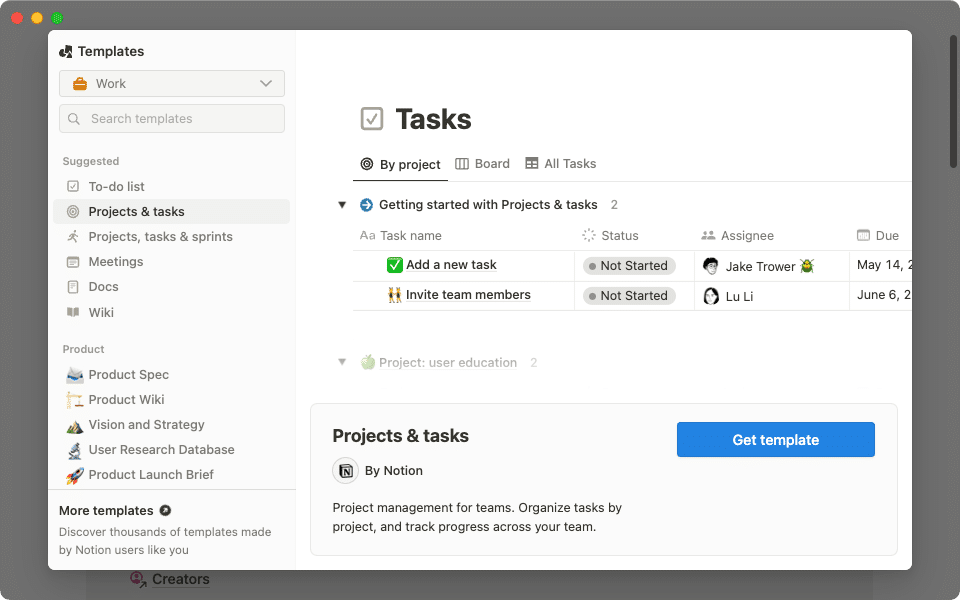
AI for Collaboration and Group Projects
In summary:
- AI tools for collaboration and group projects will help you communicate and collaborate across different projects successfully.
- They can help you and your peers stay organized and accountable for your work.
- There’s a variety of tools to choose from, but we recommend Slack and its bots and Miro.
AI-powered tools can make communication, brainstorming, and planning easier. You might not even have to meet them in person thanks to these tools!
Before you switch to using them, work with your project peers on setting guidelines, like:
- How and when to tag others
- How to track deadlines
- How and when to ping others
- How to keep the discussion going
- How to keep the project transparent and
- How to keep each other accountable.
It might seem like a bit of work at first — but if you establish this workflow and rules within it, it’ll be much easier to collaborate with people on an ongoing basis.
Here are some tools that can help with this.
Slack with integrated AI bots
Slack is like a messenger for business people. But you can also use it to communicate with your peers about collaborations and group projects.
How to use it: In addition to helping you communicate with peers instantly, they can also provide you with reminders, recap notes, polls, and other details to make your life easier.
Here are some bots you can integrate with Slack to make your lives easier:
- Remind, to set automatic reminders for assignments, exams, revision sessions, or project deadlines directly on Slack.
- Pomodoro tracker, to help with time management.
- Simple poll, to make it easier to vote for different options or preferences, or give and gather feedback on group projects or decisions.
- GDrive, to integrate with Google Drive and allow quick and easy sharing of documents, sheets, and presentations.
You can visit Slack’s app directory to browse different apps you can connect with Slack and make your group projects and communication easier.

Miro
Miro is an AI-enhanced virtual whiteboard for brainstorming and planning your projects, debates, or presentations.
How to use it: You can map out different processes and define each person’s role within Miro boards to make responsibilities more clear and make sure everyone can be held accountable for their work and deadlines (wink-wink).
Finally, Miro’s commenting and feedback features will help your crew communicate and iterate on ideas on the spot, which will hopefully make this more creative and collaborative.
The feature I find awesome is Retrospective — you can use this after each major presentation or project to make notes, reflect on what went well and what didn’t and make sure you improve in the future.
Honestly? Every nerd’s dream.
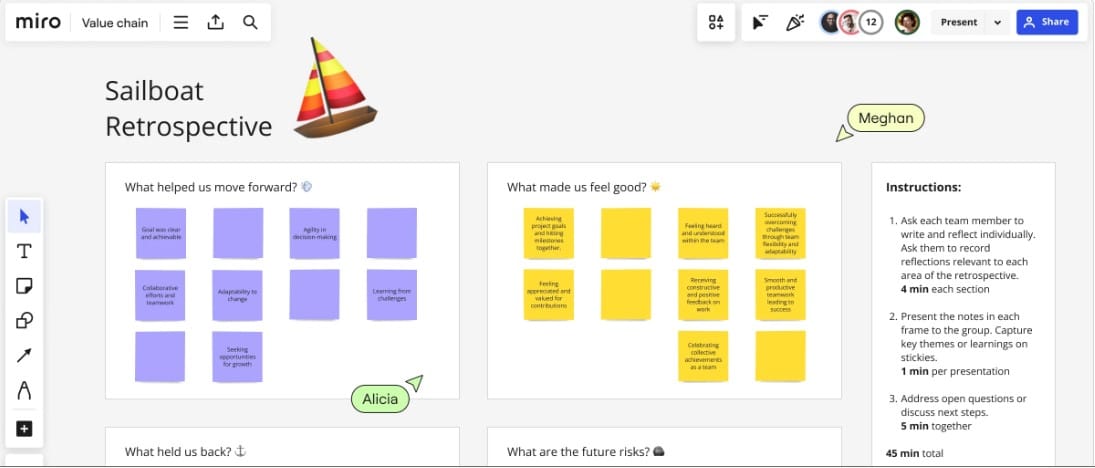
AI for Personalized Learning Plans
In summary:
- Certain AI tools can help you study more successfully by personalizing learning materials to your specific goals and needs.
- They’re a great way to stay motivated, focused, and engaged.
- Try Smart Sparrow for personalized learning.
Why should you use AI-powered tools for personalized learning plans?
- It adapts the learning materials to your needs and pace
- It keeps you engaged
- It focuses only on materials relevant to you
- It makes it easier to acquire new knowledge and reduces learning anxiety
AI tools do this by analyzing data on your performance and preferences, and then creating custom learning paths for you. They adapt in real time to your needs, provide feedback, and adjust content accordingly.
Below is a review of a tool that could be useful if you’re looking for a personalized learning plan.
Smart Sparrow
Smart Sparrow was created primarily with educational institutions in mind, so if your school or college is a user, you’ll have the opportunity to use it to its full potential. Still, it’s free for up to 5 regular users (no institutions involved), so you can try it out, although it might have some limitations.
Smart Sparrow is an adaptive learning platform that creates personalized learning plans for you.
As you progress through a lesson, it adjusts the content and difficulty level to match your learning pace and understanding. You can also receive instant feedback on your answers, so you’re aware of your mistakes and you can correct them quickly.
How to use it: When it comes to the lesson content, there are a lot of interactive lessons that will help you learn through experiments and practical application of what you learned in practice. Plus, educators who create lessons can design labs and simulations where you can explore complex concepts in a controlled environment.
This tool will also provide analytics on your performance and track your progress, engagement, and weak areas so that educators can identify learning gaps and provide you with the support you need.
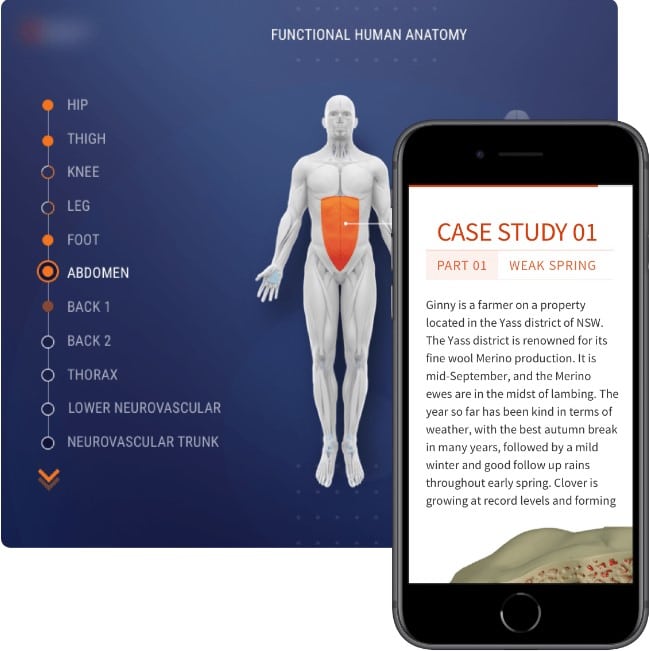
Using ChatGPT for Various Education-Related Tasks
In summary:
- ChatGPT is the most popular AI tool that can serve students in various ways: it can help with content generation, study assistance, practicing and revision, brainstorming, and even language practice.
- When using ChatGPT, aim to give full context and ask clear, specific questions for the best results.
- Use ChatGPT as a supplementary support and don’t over rely on it; always verify information provided by it.
The most popular and famous AI you can use in various ways for various tasks — ChatGPT. It’s like a friend who knows everything about…everything.
It’s because it’s been fed a huge amount of information all over the Internet. So when you ask for help, ChatGPT analyzes available information and provides you with a tailored response.
It can help you get direct answers to specific questions, but you can also use it for broader, more demanding tasks.
Finally, ChatGPT can provide personalized assistance tailored to your needs and goals, especially if you nail down the prompts correctly.
Here’s what it can do to make your life easier.
Content generation
ChatGPT can assist with:
- Writing essays
- Writing emails
- Writing creative pieces
- Informal communication like emails and texts
It’s mainly used for the latter – the key is to provide a very specific prompt so that it knows exactly what to do.
This is great because you don’t have to spend ages overthinking a simple email or a text message anymore.
But be careful with formal assignments like essays and creative writing, though. Using 100% AI-generated content is considered cheating.
Plus, there’s a ton of AI detection tools that teachers and professors use to check your writing and you’ll be sanctioned if they discover you copy-pasted an AI-generated text and handed it in as your own.
How to use it: There are smarter ways to use ChatGPT for content generation:
- Ask it to provide you with ideas for writing.
- Ask to define key concepts you’re struggling with.
- Ask it to write a draft of a text you can use it as a starting point and heavily edit it to reflect your opinions and personality.
- Ask it to analyze a piece of text you wrote and suggest improvements.
- Ask it to check the grammar and spelling of your text (but be careful as it won’t point out the mistakes — you’ll get a reworked version and you’ll have to look for changes manually).
Generally, strive to use ChatGPT as a sparring partner, a sidekick who is there to help out and provide minor assistance. The core of your work needs to be your own.
Study assistance
You can also use it as your study assistant whenever you’re stuck. It can:
- Clarify complex topics for you
- Generate summaries
- Offer explanations and illustrative examples
- Help with your homework by explaining difficult concepts, assisting with brainstorming or writing, and providing step-by-step solutions or examples
But be sure to break down your problem in a clear way and ask clear, specific questions to get the best results.
For example, if you need to write an essay on a topic, you could;
- Summarize what you know about it
- Identify areas that you’re confused about
- Give clear prompts about how you want want ChatGPT to explain the problematic parts
- Give you ideas on how to best structure the essay.
Finally, take a few minutes to fact-check anything that seems suspicious to you – or generally any important information like historical facts, numbers, etc. AI can still make mistakes and sometimes straight-up give fake information.
Practice and revision
ChatGPT can be a perfect practice partner when you’re preparing for a text or an exam. It can help you revise information and come up with different revision techniques like:
- Creating mock quizzes
- Creating flashcards
- Coming up with practice questions
Brainstorming
Although AI can’t think of new concepts and ideas on its own because it’s not a conscious entity, it still has access to an enormous amount of data.
By finding new patterns in that data, it can provide you with new ideas you can use when brainstorming.
Even if it doesn’t provide anything groundbreaking, it can be used as a starting point and you can try building on an idea from there — even better if you can work with peer(s) and exchange ideas.
To use if for brainstorming, you could:
- Provide a detailed description of what you know about the topic and then ask specific questions about the area you need help with.
- Provide a rough idea you had and ask ChatGPT to develop a detailed outline.
- Provide examples or projects you liked, and ask it to follow the same logic when coming up with suggestions.
- Make it interactive – asking ChatGPT to ask you any number of questions about what you need help with, before coming up with suggestions.
Language practice
For language learning and practice, immersion is the best technique – this means being placed in an environment where only the target language is spoken. It helps with natural language acquisition, contextual learning, and listening and speaking skills.
Of course, immersion is not always possible. And depending on what language area you want to practice, you can use ChatGPT.
How to use it: For example, you can use it to practice written communication by chatting with it in your target language. It’s a great way to practice conversational language, perhaps learn a few idioms, and similar.
I tried this out with the Serbian language. I deliberately made a grammar mistake which ChatGPT didn’t register. When asked if my sentence was grammatically correct, it confirmed that it was. It was only after I asked about the wrong tense I used that I got corrected.
So stay alert and bear in mind that it won’t always be able to spot your mistakes and correct them timely.
Still, it’s a great way to practice the most important aspect of language learning — and that’s successfully communicating your message.
How to Properly Use ChatGPT
Be clear and specific
AI-powered tools rely on the input they receive to deliver the output. If your questions or prompts are general and vague, you can expect a similar response that won’t really address your needs.
For best, most accurate results, it’s important to ask ChatGPT specific and clear questions or provide context-rich prompts.
For example: Suppose you’re writing an essay and need help with paraphrasing or organizing essay structure. In that case, you can describe the topic of the essay, the target audience, the level of language, the unique point of view you want to showcase, and other relevant details before asking ChatGPT to do something.
You can also ask ChatGPT to ask you any number of questions it needs in order to understand your problem or request before giving you a response. It will usually ask several questions to better determine the context and your needs, making the answers more accurate and relevant.
✅ Pro tip: If you’re using a paid ChatGPT version, you can adjust the settings to provide pre-existing context so that ChatGPT takes it into account before completing the task. This way you can save time because you won’t have to provide a bunch of context in your actual prompts.
Just go to the upper right corner and click on the little circle near your name, and click Customize ChatGPT.
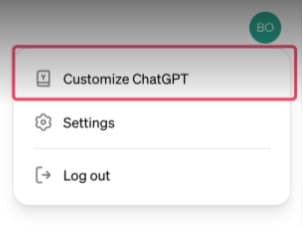
This screen will open up:
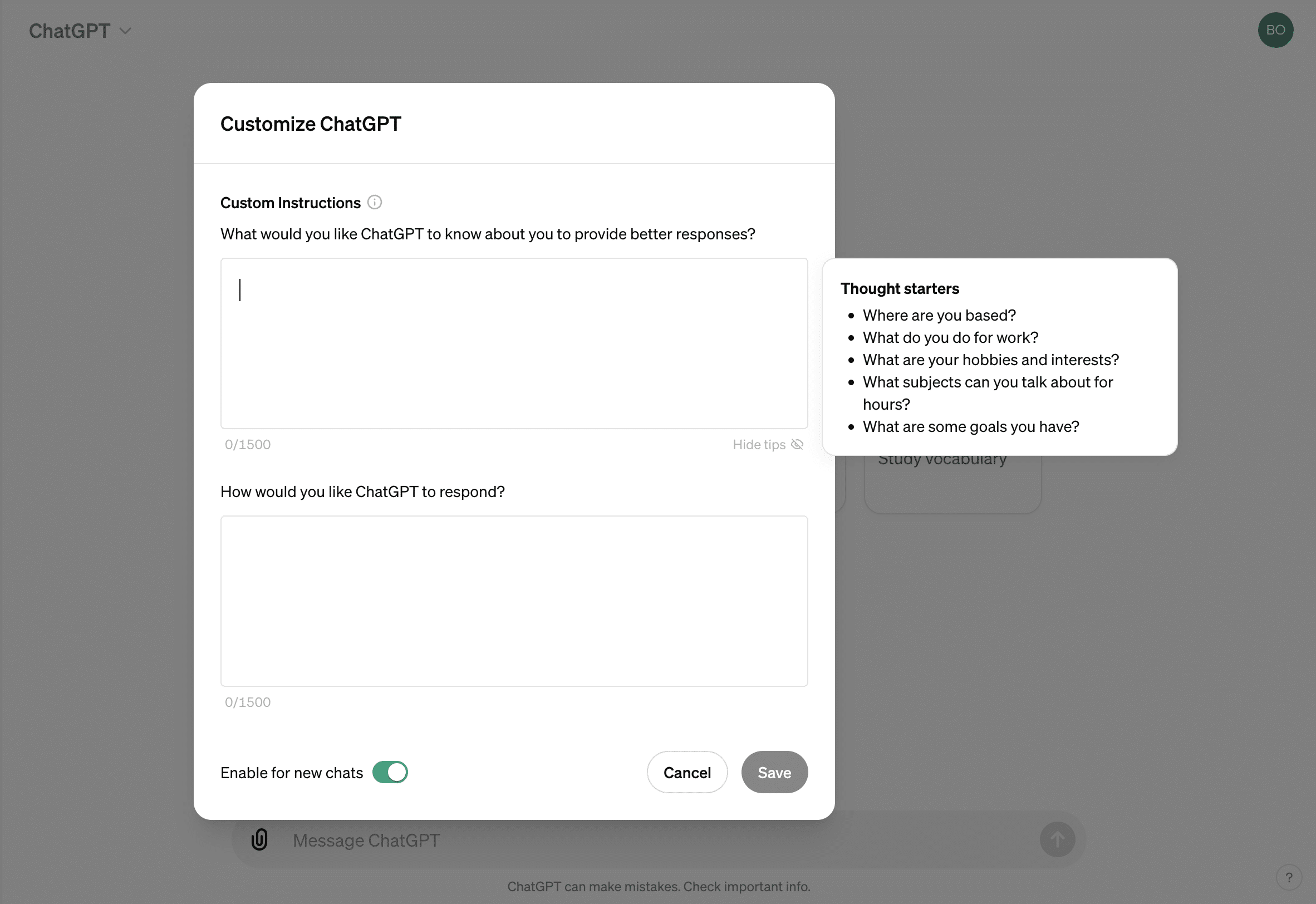
In these two boxes, you can provide more context and details about what kind of answers you’d like to get.
Use it as a supplementary support
As already mentioned, ChatGPT should be your support, a sidekick, rather than your main source of information or doing everything for you.
If you hand in an essay completely written by it, it will be obvious, and you’ll probably be penalized.
So make sure you use it for:
- Brainstorming
- Bouncing ideas
- Experimenting
- Revising
- Practicing
The core of your work still needs to be yours, but ChatGPT can provide finishing touches and tie everything together nicely.
For example: If you need to write an essay on Hamlet, but you’re not sure which idea to explore, you can provide ChatGPT with a list of ideas and motifs you came up with, and ask it to create a list of its own and then compare.
When you choose an idea or a motif, for example, madness, you can provide it with your unique point of view on it. Then ask it to compare Hamlet’s and Ophelia’s madness, why Hamlet faked madness, the impact of it on characters’ decisions, and similar.
All of this will help you gather a bunch of ideas and work your way through them, removing, adjusting, adding, editing.
Then you can create an outline for your essay and ask ChatGPT to check it and add its suggestions. Same goes for the first draft, and so on.
Verify information provided by ChatGPT
When working with factual information with ChatGPT, be sure to review and verify those facts in other reliable and official sources as well.
ChatGPT collects data from all across the Internet, and you know how much fake information there is — sometimes it will pick up on straight-up fake info, or outdated or biased information.
Summary of the Main Points
- AI tools, if used correctly, can make a world of difference and make your studying sessions much easier.
- Tools like Grammarly and QuillBot can help you with writing.
- Tutoring platforms like Khanmigo and Socratic can help with homework and test preparation.
- Zotero and Research Rabbit will help you with your research and papers.
- Time and project management tools like RescueTime and Notion will help you organize your tasks, notes, and time for maximum efficiency.
- Slack and Miro will help you communicate with peers and be more efficient with group projects.
- Smart Sparrow is great for personalized learning.
- ChatGPT will help you with various tasks, from writing, doing homework, practicing and revising, to brainstorming and practicing written language.
- No matter what AI tool you use, make sure you use it responsibly – don’t over-rely on it, check every suggestion and information, and make sure the core of your work is your own, and not AI-generated.
_______________________________
Need a hand? There are 3 ways we can help you:
- Optimize your resume in minutes with ResumeAI.
- Learn if you should take career advice from TikTok.
- Learn about career readiness and how it will help you land a job and thrive in your professional life.
FAQ
Is it wrong to use AI to write essays and other assignments for me?
It is wrong to copy-paste what AI wrote for you and hand it in as your own. Plus, you probably won’t get a great grade because the quality won’t be as good. But using AI as a helper, for generating ideas, reformulating, editing, and similar tasks is totally fine. As long as the core of the work is yours, you’re in the clear.
What are the biggest risk factors in using AI for educational purposes?
You need to be careful about bias and fairness, as AI sometimes can amplify biases that are present in the training data. Additionally, students from underrepresented groups might be at a disadvantage because AI can’t account for different backgrounds or learning styles. There’s also a lack of transparency on how AI systems arrive at certain decisions and recommendations, so it might be hard to trust it or make informed decisions based on its output. Finally, if students over-rely on AI for different tasks, it might lead to problems like decreased critical thinking and problem-solving skills.
What are some of the most useful GPT prompts that can help me in learning?
- Explain it to me like I’m 5
- Provide a detailed explanation of…
- How can I improve my memory retention of [topic]?
- Can you walk me through the steps on how to solve [a problem]?
- Summarize the main points of this topic/article/book
- What are the key takeaways from [a source/lecture/chapter]?
- Create some mock test questions for [subject/chapter]
- Create some mock test questions for [subject/chapter]
- Can you provide some grammar exercises for [language/tense]?
- What are the pros and cons of [idea/concept]?
I was falsely accused of submitting an AI-generated assignment, how do I prove I didn’t do it?
AI detection tools aren’t always accurate — perhaps paradoxically, the higher your own writing and reasoning quality, the more likely it is for your work to be flagged as AI-generated. To prove you actually wrote what you wrote, provide evidence like version and comment history in Google Docs, document metadata showing creation and modification dates, or your handwritten brainstorming, data, revisions, and similar. You can also explain your research process and illustrate it by taking someone through your notes or text outline, or by pointing out unique elements of your writing and your personal style.
What subjects can AI help me with the most?
AI-powered tools can help you with a variety of subjects. Although most commonly used for writing, there are a lot of tutoring platforms that can help you do your homework and prepare for tests and exams from pretty much any major subject, like math, literature, biology, chemistry, history, and similar. In addition to this, there’s a variety of AI tools to help you organize your work and successfully communicate with your peers and study buddies.
